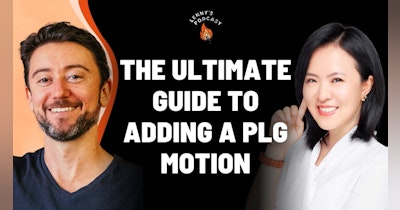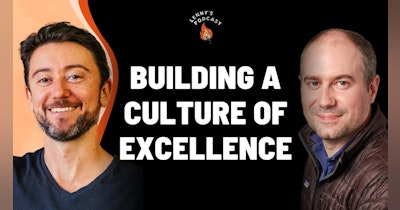April Dunford is an expert at nailing positioning for scaling tech companies and wrote Obviously Awesome, a definitive guide to product positioning. She spent 25 years leading marketing, product, and sales teams and is now an independent consultant. April has worked hands-on with over 200 companies on positioning, including Google, IBM, Postman, and Epic Games.
You can also see the episode transcript and April’s references.
April’s background ▶
April didn’t study marketing but engineering at school and worked at a startup when they were still called “small companies.” She ended up working for a “loser product” in a marketing role that she helped reposition and that took off. Her boss quit, so she became the VP of Marketing, which made her discover positioning as a fundamental concept in marketing that actually didn’t have a methodology. She is, today, talking about this methodology in her book, specifically for B2B SAAS growth stage/scale-ups.
An interesting or unusual client? Bluelight Analytics helps dentistry instruments work better; she learned so much about the industry and is scared of visiting her dentist now.
Defining positioning, and when you know you have a positioning problem ▶
Positioning as a concept is not new; it defines how your product is the best in the world at delivering some value that a well-defined set of companies care a lot about.
It's hard to measure bad or weak positioning, but you can feel a sluggishness (e.g. the lightbulb does not come on with a customer unless they have an extra sales call). So how do you assess positioning?
- Hang out with Sales. You’ll get to listen to customers who are like, “Back up and pitch it to me again. Can you say that again?” Sometimes they’d say, “Oh, you are like Salesforce” or “I can do this on a spreadsheet; why do I need you?” And in this confusion lies your positioning problem.
- Alignment across the founding team, marketing, sales, customer success, marketing: each function of the company says something different about the product!
- Sometimes the C-folks get together and say, “Okay, so why does everybody love our stuff?” This is a terrible way to go about positioning, because what you'll get is just opinions and you’ll not know a way to measure if it’s good or not.
With her client Postman, which is “a platform for building and using APIs,” they didn’t know what to call themselves three years ago, and that took work to go through her positioning exercises.
Company misalignment vs. positioning issues ▶
Most cases April has dealt with are misalignment problems within the org and not positioning problems. The founder often has the positioning story done right with their early customer calls, but their C-level team “is not doing or getting it right.” Or the market conditions have changed (e.g. during Covid), where positioning needs a re-evaluation and Product or Marketing has to convince the founders.
The essential five steps to figuring out your product’s positioning ▶
- Competitive alternatives: What do we have to position against? It’s like saying, who do you have to beat in order to win a deal?
- You often have a status quo alternative, like Zendesk, that is easy to ignore, but you shouldn’t because in B2B you lose about 40% of deals to “no decision,” which actually means you lost to the spreadsheet, you lost to pen and paper, you lost to interns. And if you’re not positioning well against that product, you’re never going to get the customer to come off that.
- Key unique attributes: What makes you different? These are key product capabilities or feature functions that the alternatives don’t have.
- Translate into value: The above unique attributes often bucket into themes of value that are differentiated.
- Customers who care are your target customers: What are the characteristics of a target account that make them really, really care a lot about that value?
- Market you win: What’s the context I position this thing in that makes my value obvious to the people I’m going after?
Help Scout’s positioning process ▶
April helped Help Scout figure out its differentiation, which was in its philosophy of customer service, where they treat their customers as humans, not a number, and a chatbot convo happens only when there is a human. Offering a high level of service, their value became the amazing service to customers, not pushing them to a low-cost channel.
And then you ask yourself, “Well, who cares a lot about that?" Not everybody, but a lot of direct-to-consumer brands or e-commerce brands do, where they see customer service as a way to really drive growth through customer loyalty.
The difference between positioning, messaging, and branding ▶
- These concepts are distinct, because positioning is a fundamental precursor to messaging. By messaging, people mean “This is the text on the homepage.” You can’t write that until you understand the value for whom.
- You can’t figure out what the “brand” stands for until you know the target buyer and the differentiation for the brand to be distinct.
- Examples:
- Magic Leap: Magic Leap is a VR headset, but April was like, so what? What am I actually going to do with that? She helped them pivot to selling B2B for manufacturing companies.
- Segway: Segway’s founder pitched “Revolution in human transport.” And people were getting so excited because they believed it was a flying car. And then when they saw the actual product, they were disappointed because they saw a moped and didn’t know what to compare it to.
How should early-stage companies think about positioning? ▶
- The actual 5-step exercise above takes a week and depends on how contentious the existing alignment is.
- For an early-stage company trying to find PMF, the positioning makes less sense, because there is a lot of validation of the product hypothesis first. Allow the market and customers to pull you as opposed to nailing positioning. For example, if you are selling fish nets—if your thesis is that it’s only for tuna, if it fails, it fails hard. In the beginning, you can just use it for all kinds of big fish and let’s see where it goes. Maybe it’s good for grouper, and this you figure out by being flexible.
- You feel the need for nailing positioning when you start seeing common patterns with the customers, e.g. they all have Zendesk, are 50-people strong, and are yet to hire their COO.
What’s the difference between segmentation and personas? ▶
- In B2B, you first segment your customers via firmographics, i.e. things like how many employees, revenue, geography, etc. Then, a more actionable segmentation is: “three-member or more creative agencies that follow a specific firmographic profile and have a budget of 20K and they use Notion.” Often in enterprise B2B decision-making, there are between five and seven people involved, so the tighter your segment, the more effective your marketing team is.
- After segmentation, personas come to know who the internal champion of the prospective buyer is. For example, this could be John, who is the head of Sales Ops, and it’s his responsibility to build consensus and galvanize the deal, including their boss, who’s the actual check writer. John becomes the gatekeeper and the most important persona, and if your product is not differentiated, you don’t get on John’s shortlist.
This is a human edited summary of the podcast episode with April, by Gaurav Chandrashekar (@cggaurav, productscale.xyz). To listen to the full episode, go here.








